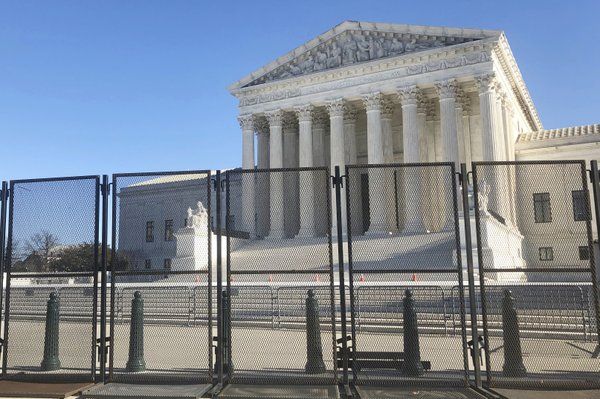Dobbs overrules Roe: Welcome to a new America
No American woman under 50 has lived in a country where her choice to have an abortion was not constitutionally-protected. That may all change this summer with the Supreme Court's decision in Dobbs v. Jackson Women's Health Organization. And that may be only the beginning.

1. The draft opinion in Dobbs v. Jackson Women's Health Organization
The draft opinion in Dobbs vs. Jackson Women’s Health Organization, released this week by Politico and subsequently verified by Chief Justice John Roberts, is not yet the law of the land, but it would be wise to proceed as if it were. Here are grotesque oversimplifications of the original Roe v. Wade and the draft opinion in Dobbs:
Roe: The Constitution guarantees both enumerated and unenumerated, or implied, liberties. Beginning in the early 20th Century, Supreme Court cases recognized a right to “personal, marital, familial and sexual privacy.”[1] Roe ruled that those liberties included a woman’s right to have an abortion, at least until such time as a fetus’s viability allowed the State to assert its interest in protecting life and regulate that right.
Dobbs: The rights protected by the original Constitution are those explicitly enumerated; if not explicit, “any such right must be ‘deeply rooted in this Nation's history and tradition’ and ‘implicit in the concept of ordered liberty.’ … The right to abortion does not fall within this category.”[2] Since there is no constitutional interest in protecting a woman’s right to choose, the Congress and the states are free to regulate it as they see fit.
These are profoundly different modes of analysis. The Roe Court thought that the Constitution was intended to respond to what Thomas Jefferson called "the progress of the human mind":
As that becomes more developed, more enlightened, as new discoveries are made, new truths disclosed, and manners and opinions change with the change of circumstances, institutions must advance also, and keep pace with the times. We might as well require a man to wear still the coat which fitted him when a boy, as civilized society to remain ever under the regimen of their barbarous ancestors.
The Dobbs majority, on the other hand, starts with the letter of the Constitution and moves beyond that only with great caution. The constitution must be interpreted based on the original understanding "at the time it was adopted." The original meaning is changed only by amending the Constitution as, for example, when we banned slavery in the Thirteenth Amendment. Conservative legal scholars call this "Originalism;" others call it "protecting the patriarchy."
2. Abortion rights are only the beginning
The impact of Dobbs on access to abortion will be profound – more on that below. Legal commentators also have noted the impact the reasoning could have on other rights, many of which we take for granted. Although the draft opinion claims that it applies only to abortion and not to other unenumerated rights, the reasoning above would apply to any number of other “rights” commonly accepted in America now. In a prescient article written last fall, law professor Kimberly Wehle mentions just a few of the procedents that could fall under the Dobbs reasoning:
The Court has construed liberty to safeguard numerous other personal safe spaces: the right to marry regardless of race (1967’s Loving v. Virginia) and sex (2015’s Obergefell v. Hodges). The right to use contraception (Griswold). The right to be free from compulsory sterilization by the state (1942’s Skinner v. Oklahoma). The right to be free of government-mandated surgery involving “a virtually total divestment of respondent’s ordinary control over surgical probing beneath his skin” (1985’s Winston v. Lee). And the right to engage in intimate sexual conduct with a partner of one’s choice without fear of criminal prosecution (2003’s Lawrence v. Texas).
As University of Texas Law School professor Steve Vladeck points out,
It’s a theoretical concern for the moment but I live in Texas and it’s not hard to imagine the Texas Legislature not being shy when it comes to pushing the envelope. What a ruling like this does is get all of these politicians in red states to think: ‘What haven’t we done because we thought we couldn’t?’
3. Dobbs will profoundly limit abortion rights nationwide
The Dobbs decision, if it remains in its current form, will profoundly affect access to abortion in Texas and the United States. Over the years, Roe has protected Texans from the worst theorcratic impulses of our Legislature, although the protections have grown weaker recently. Last spring, the Legislature passed S.B. 8, a ban on abortions after six weeks. To kneecap courts' efforts to review the bill, the statute authorizes "bounty hunters." The New York Times explains:
It removes enforcement entirely from state jurisdiction, and vastly expands who can sue, and who can be sued, over abortions. The statute, for example, permits anyone — even people who live outside Texas — to file a complaint in any court in the state if they believe an abortion has been performed. It also makes nearly everyone involved in the procedure — except for the woman who receives the abortion — liable to suits, meaning that doctors, nurses, insurance companies, even Uber drivers who help take women to clinics, could be vulnerable.
If there's no "state action," then the ability of courts to review the law is very circumscribed. This dodge was enough to get both the Texas and U.S. Supreme Courts to declare they were powerless to stop implementation of H.B. 8. And, because misery loves company, other states immediately started passing "bounty hunter" abortion bills.
But the Texas Lege wasn't done. Last spring, the Lege also passed a “trigger law,” completely outlawing abortion in the event that Roe was overruled, with no exceptions for rape or incest. Assuming the Dobbs draft opinion remains mostly intact, by late summer performing an abortion could be a felony in the Lone Star State.
The national picture is similarly depressing. The Washington Post produced this helpful graphic of the state of affairs in all the states. While about half the states would restrict or ban abortions, only 16 have laws that would protect the right to choose.

The Post also produced a more detailed analysis of the state of abortion regulations nationwide.
4. For antiabortion activists, reversing Roe is just the beginning
Roe v. Wade has been settled law during the lifetime of over half of all living Americans. For antiabortion activists, eliminating Roe would be a major victory, for some the culmination of their life's work. But it would not be enough. As law professor Mary Ziegler pointed out in a 2021 interview with Slate magazine,
The short-term answer is getting rid of Roe. The longer-term answer would be getting a conservative Supreme Court to recognize fetal personhood or a “right to life.” That’s the only logically consistent goal. If you believe life begins at conception, how is it OK for abortion to take place in Manhattan or Honolulu? And historically, that was never the goal. The states’ rights approach emerged as a necessary second-best solution after Roe. It has never been the endgame, even for the more sophisticated incrementalist folks. They do not want legal abortion anywhere in America.
The idea that abortion should be regulated by the 50 states was a feature of dissents in Roe and other abortion rights cases, but Alito's draft is careful not to preclude federal action:
Anti-abortion groups are already working with Republican lawmakers to push for a federal ban after Roe falls. The Washington Post reports that leaders of the anti-abortion movement are pushing for a six-week ban—which would, in reality, give patients less than two weeks to terminate a pregnancy. Marjorie Dannenfelser, president of the anti-abortion Susan B. Anthony List, has discussed the idea with Republicans who hope to run for president in 2024; most, she told the Post, agreed to “make that policy a centerpiece of a presidential campaign.” At least ten other organizations are asking GOP members of Congress to commit to a six-week ban.
Congress is already weighing its post-Roe options. As of this month, 19 senators and more than 100 representatives—all Republicans—have cosponsored sweeping legislation that would grant legal personhood from the “moment of fertilization.” This law would prohibit all abortions at every stage of pregnancy, as well as many common IVF procedures, by granting due process and equal protection rights to fetuses and embryos. Other more incremental bills would make it a federal crime to transport a minor across state lines to help her terminate a pregnancy without parental consent. At a bare minimum, Republicans appear dead set on enacting a federal ban at 15 or 20 weeks, nullifying state laws that allow abortion later in pregnancy.
5. What is to be done?
Abortion rights supporters have gone to Defcon One. (Side note: what were they waiting for? Everyone except Susan Collins knew this Supreme Court majority was being assembled specifically to overrule Roe – including the justices.)
They have proposed a simple three-step process: 1) Pass a federal law protecting abortion rights. 2) Since such a law is D.O.A. in the Senate because of the filibuster, eliminate the filibuster. 3) As long as you've got no filibuster to worry about, pack the Supreme Court with additional, pro-choice justices.
Easy peasy, lemon squeezy.
This is nonsense, for two reasons. First, it cannot be accomplished before the fall elections and, if it could, could just as easily be undone after the fall elections dump the Democrats from power. Second, it feeds into the self-serving narrative that the Congress, lobby and advocacy groups, and the D.C. media monster that feeds on them, are actually in charge. Which they're not.
It's worth worrying about the draconian laws discussed above. It's also important to note the state-level bans and restrictions that will be triggered by Dobbs. But nothing will change unless elected representatives think and act differently about the politics of abortion rights.
Public opionion polls consistently show support for abortion rights, particularly during the first 16 weeks of pregnancy. Gallup polling over the years shows that support for complete abortion bans it limited to about one-fifth of the population.
Even in Texas. A poll last month by the Texas Politics Project at UT Austin found that 78% of Texas, including 69% of Republicans, favor some sort of access to abortion.
But support does not always translate into activism. Now we will find out: how important is that protection, really? Two questions:
1. Will this public support for abortion rights translate into political and electoral pressure – block walks, fundraising, voting – affecting the outcome of elections this fall?
2. Will the Texas legislative majority and state leadership – chosen as they are by the most rabid and active partisans on the reactionary right – care?
I don't know the answer to the first question, but it is the only way anything is going to change. I am afraid I do to the second.
[1] Roe v. Wade, 410 U.S. 113 (1973) at 129, citing Griswold v. Connecticut, 381 U. S. 479 (1965).
[2] Dobbs vs. Jackson Women’s Health Organization, draft opinion at 5.
